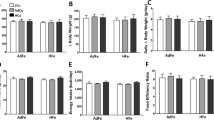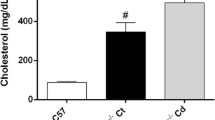Abstract
Copper is an essential trace element in the maintenance of the cardiovascular system. Copper-deficient diets can elicit, in animals, structural and functional changes that are comparable to those observed in coronary heart disease. In this study, the effect of dietary-induced copper deficiency on aortic lesion development was measured by quantitative image analysis in C57BL/6 mice that are susceptible to diet-induced aortic lesions. The diets administered were severely copper deficient (0.2 mg/kg diet), marginally deficient (0.6 mg/kg diet), or copper adequate (6.0 mg/kg diet). Similarly, increased aortic lesion areas and elevated serum cholesterol were demonstrated in both deficient groups, compared with the copper-adequate group. Evidence for graded differences in copper status among the dietary groups was shown by the dose-response increase in liver copper concentration, copper-zinc superoxide dismutase and cytochrome-c oxidase activities, together with serum caeruloplasmin oxidase with increasing intakes of dietary copper. Despite the difference in copper status between the copper marginal and severely deficient groups, similar lesions found in both groups of mice suggest a threshold effect of copper deficiency on lesion formation.
Similar content being viewed by others
References
M. Olivaries and R. Uauy, Copper as an essential micro-nutrient, Am. J. Clin. Nutr. 63(Suppl.), 791–796, (1996).
R. Uauy, M. Olivaries, and M. Gonzalez, Essentially of copper in humans, Am. J. Clin. Nutr. 67(Suppl.), 952–959 (1998).
V. Jutum, Copper and cardiovascular disease, Trace Elem. Electrolytes 16, 55–60 (1999).
K. G. D. Allen and L. M. Klevay, Copper: an antioxidant nutrient for cardiovascular health, Curr. Opin. Lipidol. 5, 22–28 (1994).
D. M. Mederios and R. C. E. Wildman, Newer findings on a unified perspective of copper restriction and cardiomyopathy, Proc. Soc. Exp. Biol. Med. 215, 299–313 (1997).
R. Nath, Copper deficiency and heart disease. Molecular basis, recent advances and current concepts, Int. J. Biochem. Cell Biol. 29, 1245–1254 (1997).
T. Jalial, D. M. Mederios, and R. E. C. Wildman, Aspects of cardiomyopathy are exacerbated by dietary fat in copper restricted rats, J. Nutr. 126, 807–816 (1996).
S. M. Mao, D. M. Mederios, and R. E. C. Wildman, Cardiac hypertrophy in copper deficient rats is owing to increased mitochondria, Biol. Trace Element Res. 64, 175–184 (1998).
J. R. Prohaska, Changes in Cu, Zn SOD, CCO, GPx and gluthatione transferase activities in copper deficient mice and rats, J. Nutr. 121, 355–363 (1991).
J. R. Prohaska, Response of rat cuproenzymes to variable dietary copper, J. Nutr. Biochem. 8, 316–321 (1997).
C. C. Lai, W. W. Huang, A. Askari, L. M. Klevay, and T. H. Chin, Expression of GPx and catalase in copper deficient rat liver and heart, J. Nutr. Biochem. 6, 256–262 (1995).
L. Rossi, M. R. Ciriolo, E. Marchesse, A. Demartino, M. Giorgi, and G. Rotilo, Differential decrease of copper content and copper binding to SOD in liver, heart and brain of copper-deficient rats, Biochem. Biophys. Res. Commun. 203, 1028–1034 (1994).
L. Rossi, G. Lippe, E. Marchesse, A. De Mertino, I. Marelli, G. Rotilio, et al., Decrease in CCO protein in heart mitochondria of copper deficient rats, Biometals 11, 207–212 (1998).
I. Bureau, C. G. Lewis, and M. Fields, Effect of hepatic iron on hypercholesterolaemia and hypertriglycaemia in copper deficient, fructose fed rats, Nutrition 14, 366–371 (1998).
A. A. Al-Othmann, F. Rosenstein, and K. Lei, Copper deficiency increases in vivo synthesis of fatty acids, triacylglycerols ans phospholipids in rats, Proc. Soc. Exp. Med. Biol. 204, 97–103 (1993).
A. A. Al-Othmann, F. Rosenstein, and K. Y. Lei, Pool size and concentration of plasma cholesterol are increased and tissue copper levels are reduced during early stages of copper deficiency in rats, J. Nutr. 124, 628–635 (1994).
F. H. Nielsen and D. B. Milne, High dietary fructose affects plasma cholesterol concentrations and signs of short-term copper deprivation in men, Proc. Natl. Acad. Sci. USA 46, 73 (1992).
S. K. Nelson, C. C. Huang, M. M. Matthias, and K. G. D. Allen, Copper-marginal and copper deficient diets decrease aortic prostacyclin production and copper-dependent SOD activity and increase lipid peroxidation in rats, J. Nutr. 122, 2102–2108 (1992).
A. Mazur, E. Gneux, I. Bureau, C. FilletCourdray, E. Rock, and T. Rayssiguier, Copper deficiency and lipid peroxidation, Atherosclerosis 137, 443–445 (1998).
P. K. Singal, N. Kharper, V. Palace, and D. Kumar, The role of oxidative stress in the genesis of heart disease, Cardiovasc. Res. 40, 426–432 (1998).
P. Holioet and D. Collen, Oxidation of lipoproteins in the pathogenesis of atherosclerosis, Atherosclerosis 137(Suppl.), 33–38 (1998).
Sub-committee on the 10th edition of the Recommended Dietary Allowances, Food and Nutrition Board, in National Research Council: Recommended Dietary Allowances, 10th ed., National Academy, Washington DC (1989).
L. M. Klevay, J. P. Buchet, and V. W. Buker, Copper in the Western diet. (Belgium, Canada, UK and USA), in Trace Elements in Man and Animals, M. Anke, D. Meisser, and C. F. Mills, eds., TEMA 8, Verlag Media Tourustik, Gersdorf, pp. 207–210 (1993).
L. M. Klevay and D. M. Mederios, Deliberations and evaluations of the approaches, endpoints and paradigrams for dietary recommendations about copper, J. Nutr. 26(Suppl.), 2419–2426 (1993).
P. J. Aggett and Fairweather-Tait. Adaptation to high and low copper intakes its relevance to estimated safe and adequate dietary intakes. Am. J. Clin. Nutr. 67(Suppl.), 965–971 (1998).
B. Paigen, B. Ishida, J. Verstuyft, r. B. Winters, and D. Albee, Atherosclerosis susceptibility differences among progenitors of recombinant inbred strains of mice, Atherosclerosis 10, 316–323 (1990).
J. L. Stewart-Phillips and J. Lough, Pathology of atherosclerosis in cholesterol-fed susceptible mice, Atherosclerosis 90, 211–218 (1991).
P. G. Reeves, L. R. Kerry, and L. A. Johnson, Maintenance requirements for copper in adult mice fed AIN-93M rodent diet, Nutr. Res. 14, 1219–1226 (1994).
P. M. Nishina, J. Verstuyft, and B. Paigen, Synthetic low and high fat diets for the study of atherosclerosis in the mouse, J. Lipid Res. 31, 859–869 (1990).
P. M. Nishina, S. Lowe, J. Verstuyft, J. K. Naggert, F. A. Kuypers, and B. Paigen, Effects of dietary fats from animal and plant sources on diet induced fatty streak lesions in C57BL/6 mice, J. Lipid Res. 34, 1413–1422 (1993).
B. Paigen, A. Morrow, R. A. Holmes, D. A. Mitchell, and R. A. Williams, Quantitative assessment of atherosclerotic lesions in mice, Atherosclerosis 68, 231–240 (1987).
D. G. Jones and N. F. Suttle, Some effects of copper deficiency on leucocyte function in cattle and sheep, Res. Vet. Sci. 31, 151–156 (1981).
D. E. Paglia and W. N. Valentine, Studies on the quantitative and qualitative characterisation of erythrocyte glutathione peroxidase, J. Lab. Clin. Med. 70, 158–157 (1967).
L. Smith, Spectrophotometric assay of cytochrome c oxidase, in Methods of biochemical analysis, D Glick, ed., Wiley, New York, pp. 427–434 (1955).
H. E. Abei, Catalase, Methods Enzymol. 2, 121–126 (1974).
M. M. Bradford, A rapid and sensitive method for the quantification of microgram quantities of protein utilising the principle of protein-dye binding, Anal. Biochem. 72, 248–254 (1976).
R. J. Henry, N. Chiamori, S. L. Jacobs, and M. Segalove, Determination of caeruloplasmin oxidase in serum, Proc. Soc. Exp. Biol. Med. 104, 620–624 (1960).
N. Y. Yount, D. J. McNamara, A. A. Al-Othmann, and K. Y. Lei, The effect of copper deficiency on rat hepatic 3-hydroxy-3-methylglutaryl-CoA reductase activity, J. Nutr. Biochem. 1, 21–27 (1990).
S. I. Koo, C. C. Lee, and L. Sabin, Effect of copper deficiency on the hepatic synthesis and release of cholesterol, J. Nutr. Biochem. 4, 162–167 (1993).
B. W. C. Lau and L. M. Klevay, Plasma leicithin: cholesterol acyltransferase in copperdeficient rats, J. Nutr. 111, 1698–1703 (1981).
J. R. Prohaska, Serum cholesterol levels are not elevated in young copper-deficient rats, mice or brindled mice, J. Nutr. 115, 1701–1707 (1985).
A. Mazur, F. Nassir, E. Gueux, P. Cardot, J. bellanger, M. Lamand, et al., The effect of dietary copper on rat plasma apolipoprotein E and apolipoprotein gene expression in liver and intestine, Biol. Trace Element Res. 34, 107–112 (1992).
S. C. Crosswell and K. Y. Lei, Effect of copper deficiency on the apolipoprotein E-rich high density lipoprotein in rats, J. Nutr. 115, 473–482 (1985).
T. P. Carr and K. Y. Lei, High-density lipoprotein cholesteryl ester and protein catabolism in hypercholsterolaemic rats induced by copper deficiency, Metabolism 39, 518–524 (1990).
F. Nassir, A. Mazur, C. Serougne, E. Gueux, and Y. Rayssiguier, Hepatic apolipoprotein B synthesis in copper-deficient rats, FEBS Lett. 322, 33–36 (1993).
Y. Rayssiguier, E. Gueux, L. Bussiere, and A. Mazur, Copper deficiency increases the susceptibility of lioproteins and tissues to peroxiddation in rats, J. Nutr. 123, 1343–1348 (1993).
C. Motta, E. Gueux, A. Mazur, and Y. Rayssiguier, Lipid fluidity of triacyglycerol-rich lipoproteins isolated from copper-deficient rats, Br. J. Nutr. 75, 767–773 (1996).
C. W. Levenson, Mechanisms of copper conservation in organs, Am. J. Clin. Nutr. 67(Suppl.), 978–981 (1998).
M. C. Linder, L. Wooten, P. Cerveza, S. Cotton, R. Shulze, and N. Lomeli, copper transport, Am. J. Clin. Nutr. 67(Suppl.), 965–971 (1998).
J. J. Strain, Putative role of dietary trace elements in coronary heart disease and cancer, Br. J. Biomed. Sci. 51, 241–251 (1994).
M. Fields, Role of trace elements in coronary heart disease, Br. J. Nutr. 81, 85–86 (1999).
Author information
Authors and Affiliations
Rights and permissions
About this article
Cite this article
Hamilton, I.M.J., Gilmore, W.S. & Strain, J.J. Marginal copper deficiency and atherosclerosis. Biol Trace Elem Res 78, 179–189 (2000). https://doi.org/10.1385/BTER:78:1-3:179
Received:
Revised:
Accepted:
Issue Date:
DOI: https://doi.org/10.1385/BTER:78:1-3:179




